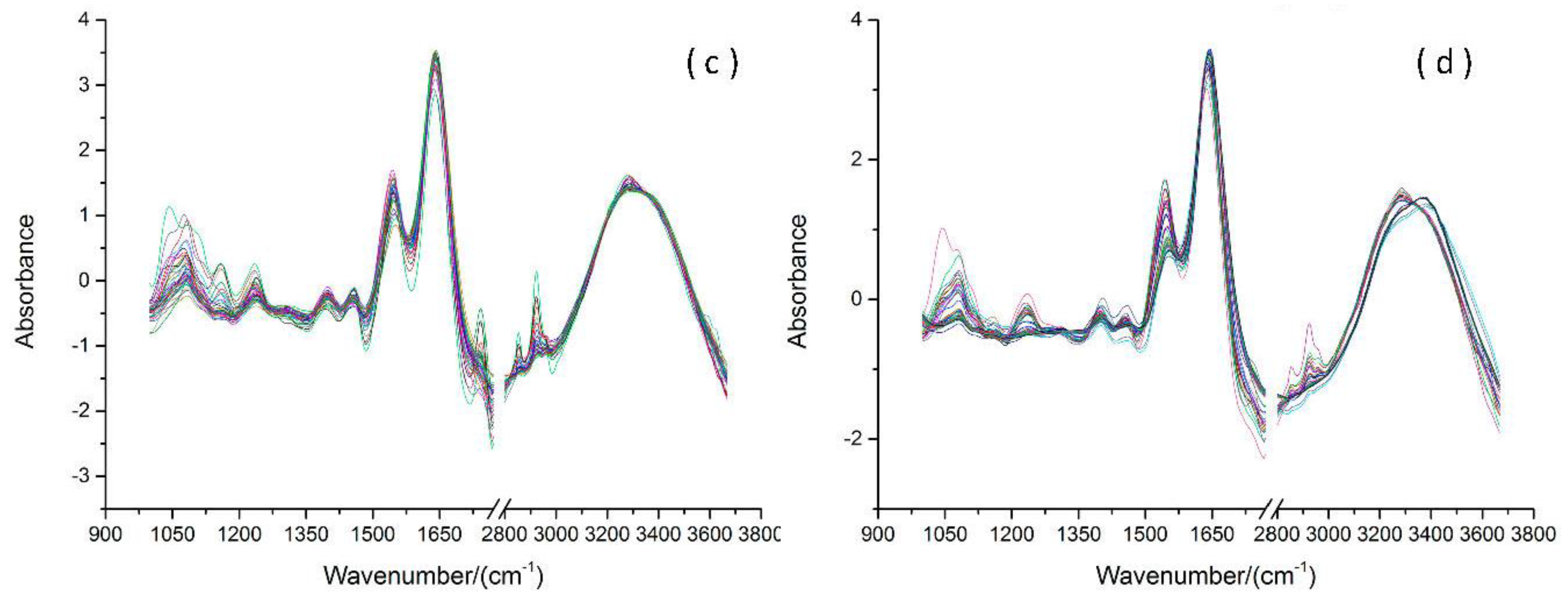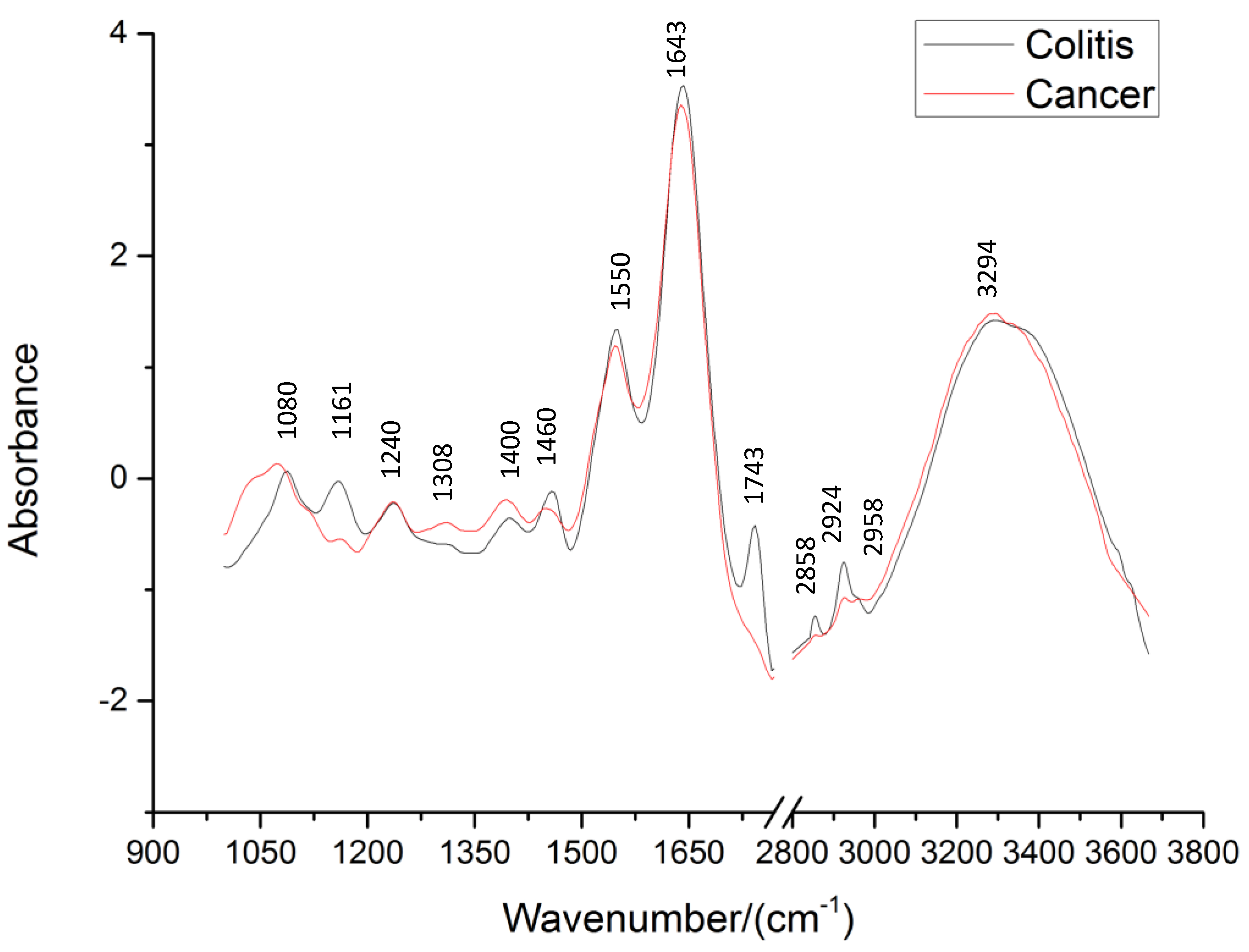Colorectal Cancer and Colitis Diagnosis Using Fourier Transform Infrared Spectroscopy and an Improved K-Nearest-Neighbour Classifier
Abstract
:1. Introduction
2. Materials and Methods
2.1. Tissue Specimens
2.2. Instrumentation and FTIR Data Collection
2.3. Spectra Preprocessing Method
2.4. Entropy Weight Local-Hyperplane K-Nearest Neighbor Method
3. Results and Discussion
3.1. Preprocessing of FTIR Spectra
3.2. Analysis of FTIR Spectra
3.3. Classification Analysis
4. Conclusions
Acknowledgments
Author Contributions
Conflicts of Interest
References
- Chen, H.; Lin, Z.; Tan, C. Cancer Discrimination Using Fourier Transform Near-Infrared Spectroscopy with Chemometric Models. J. Chem. 2015, 2015, 1–8. [Google Scholar] [CrossRef]
- Li, S.X.; Chen, G.; Zhang, Y.J.; Guo, Z.Y.; Liu, Z.M.; Xu, J.F.; Li, X.Q.; Lin, L. Identification and characterization of colorectal cancer using Raman spectroscopy and feature selection techniques. Opt. Express 2014, 22, 25895–25908. [Google Scholar] [CrossRef] [PubMed]
- Tatarkovič, M.; Miškovičová, M.; Šťovíčková, L.; Synytsya, A.; Petruželka, L.; Setnička, V. The potential of chiroptical and vibrational spectroscopy of blood plasma for the discrimination between colon cancer patients and the control group. Analyst 2015, 140, 2287–2293. [Google Scholar] [CrossRef] [PubMed]
- Rogler, G. Chronic ulcerative colitis and colorectal cancer. Cancer Lett. 2014, 345, 235–241. [Google Scholar] [CrossRef] [PubMed] [Green Version]
- Jawaid, S.; Talpur, F.N.; Sherazi, S.T.H.; Nizamani, S.M.; Khaskheli, A.A. Rapid detection of melamine adulteration in dairy milk by SB-ATR-Fourier transform infrared spectroscopy. Food Chem. 2013, 141, 3066–3071. [Google Scholar] [CrossRef] [PubMed]
- Zhang, L.; Zhang, L.M.; Li, Y.; Liu, B.P.; Wang, X.P.; Wang, J.D. Application and improvement of partial-least-squares in Fourier transform infrared spectroscopy. Spectrosc. Spect. Anal. 2005, 25, 1610–1613. [Google Scholar]
- Lasch, P.; Haensch, W.; Naumann, D.; Diem, M. Imaging of colorectal adenocarcinoma using FT-IR microspectroscopy and cluster analysis. Biochim. Biophys. Acta 2004, 1688, 176–186. [Google Scholar] [CrossRef] [PubMed]
- Piva, J.A.D.A.C.; Silva, J.L.R.; Raniero, L.J.; Lima, C.S.P.; Arisawa, E.A.L.; Oliveira, C.D.; Canevari, R.D.A.; Ferreira, J.; Martin, A.A. Biochemical imaging of normal, adenoma, and colorectal adenocarcinoma tissues by fourier transform infrared spectroscopy (FTIR) and morphological correlation by histopathological analysis: Preliminary results. Rev. Bras. Eng. Biomed. 2015, 31, 10–18. [Google Scholar] [CrossRef]
- Chonanant, C.; Jearanaikoon, N.; Leelayuwat, C.; Limpaiboon, T.; Tobin, M.J.; Jearanaikoon, P.; Heraud, P. Characterisation of chondrogenic differentiation of human mesenchymal stem cells using synchrotron FTIR microspectroscopy. Analyst 2011, 136, 2542–2551. [Google Scholar] [CrossRef] [PubMed]
- Gao, X.X.; Yao, H.W.; Du, J.K.; Zhao, M.X.; Qi, J.; Li, H.Z.; Pan, Q.H.; Xu, Y.Z.; Wu, J.G. Study on Malignant and Normal Rectum Tissues Using IR and H-1 and P-31 NMR Spectroscopy. Spectrosc. Spect. Anal. 2009, 29, 969–973. [Google Scholar]
- Walsh, M.J.; German, M.J.; Singh, M.; Pollock, H.M.; Hammiche, A.; Kyrgiou, M.; Stringfellow, H.F.; Paraskevaidis, E.; Martin-Hirsch, P.L.; Martin, F.L. IR microspectroscopy: Potential applications in cervical cancer screening. Cancer Lett. 2007, 246, 1–11. [Google Scholar] [CrossRef] [PubMed]
- Wu, J.G.; Xu, Y.Z.; Sun, C.W.; Soloway, R.D.; Xu, D.F.; Wu, Q.G.; Sun, K.H.; Weng, S.F.; Xu, G.X. Distinguishing malignant from normal oral tissues using FTIR fiber-optic techniques. Biopolymers 2001, 62, 185–192. [Google Scholar] [CrossRef] [PubMed]
- Yao, H.W.; Liu, Y.Q.; Fu, W.; Shi, X.Y.; Zhang, Y.F.; Xu, Y.Z. Initial Research on Fourier Transform Infrared Spectroscopy for the Diagnosis of Colon Neoplasms. Spectrosc. Spect. Anal. 2011, 31, 297–301. [Google Scholar]
- Du, J.K.; Shi, J.S.; Sun, X.J.; Wang, J.S.; Xu, Y.Z.; Wu, J.G.; Zhang, Y.F.; Weng, S.F. Fourier transform infrared spectroscopy of gallbladder carcinoma cell line. HBPD Int. 2009, 8, 75–78. [Google Scholar] [PubMed]
- Bai, Y.K.; Yu, L.W.; Zhang, L.; Fu, J.; Leng, H.; Yang, X.J.; Ma, J.Q.; Li, X.J.; Li, X.J.; Zhu, Q.; et al. Research on Application of Fourier Transform Infrared Spectrometry in the Diagnosis of Lymph Node Metastasis in Gastric Cancer. Spectrosc. Spect. Anal. 2015, 35, 599–602. [Google Scholar]
- Tian, P.R.; Zhang, W.T.; Zhao, H.M.; Lei, Y.T.; Cui, L.; Wang, W.; Li, Q.B.; Zhu, Q.; Zhang, Y.F.; Xu, Z. Intraoperative diagnosis of benign and malignant breast tissues by fourier transform infrared spectroscopy and support vector machine classification. Int. J. Clin. Exp. Med. 2015, 8, 972–981. [Google Scholar] [PubMed]
- Dong, L.; Sun, X.J.; Chao, Z.; Zhang, S.Y.; Zheng, J.B.; Gurung, R.; Du, J.K.; Shi, J.S.; Xu, Y.Z.; Zhang, Y.F.; et al. Evaluation of FTIR spectroscopy as diagnostic tool for colorectal cancer using spectral analysis. Spectrochim. Acta A Mol. Biomol. Spectrosc. 2014, 122, 288–294. [Google Scholar] [CrossRef] [PubMed]
- Nallala, J.; Diebold, M.D.; Gobinet, C.; Bouché, O.; Sockalingum, G.D.; Piot, O.; Manfait, M. Infrared spectral histopathology for cancer diagnosis: A novel approach for automated pattern recognition of colon adenocarcinoma. Analyst 2014, 139, 4005–4015. [Google Scholar] [CrossRef] [PubMed]
- Yao, H.W.; Shi, X.Y.; Zhang, Y.F. The Use of FTIR-ATR Spectrometry for Evaluation of Surgical Resection Margin in Colorectal Cancer: A Pilot Study of 56 Samples. J. Spectrosc. 2014, 2014, 1–4. [Google Scholar] [CrossRef]
- Gao, Y.F.; Huo, X.W.; Dong, L.; Sun, X.J.; Sai, H.; Wei, G.B.; Xu, Y.Z.; Zhang, Y.F.; Wu, J.G. Fourier transform infrared microspectroscopy monitoring of 5-fluorouracil-induced apoptosis in SW620 colon cancer cells. Mol. Med. Rep. 2015, 11, 2585–2591. [Google Scholar] [CrossRef] [PubMed]
- Sattlecker, M.; Baker, R.; Stone, N.; Bessant, C. Support vector machine ensembles for breast cancer type prediction from mid-FTIR micro-calcification spectra. Chemom. Intell. Lab. 2011, 107, 363–370. [Google Scholar] [CrossRef]
- Li, X.; Li, Q.B.; Xu, Y.Z.; Zhang, G.J.; Wu, J.G.; Yang, L.M.; Ling, X.F.; Zhou, X.S.; Wang, J.S. Application of KNN method to cancer diagnosis using Fourier-transform infrared spectroscopy. Spectrosc. Spect. Anal. 2007, 27, 439–443. [Google Scholar]
- Li, Q.B.; Xu, Z.; Zhang, N.W.; Zhang, L.; Wang, F.; Yang, L.M.; Wang, J.S.; Zhou, S.; Zhang, Y.F.; Zhou, X.S.; et al. In vivo and in situ detection of colorectalcancer using Fouriertransform infrared spectroscopy. World J. Gastroenterol. 2005, 11, 327–330. [Google Scholar] [CrossRef] [PubMed]
- Okun, O.G. K-Local Hyperplane Distance Nearest Neighbor Algorithm and Protein Fold Recognition. Pattern Recognit. Image Anal. 2007, 17, 621–630. [Google Scholar] [CrossRef]
- Xu, J.; Yang, J.; Lai, Z.H. K-Local hyperplane distance nearest neighbor classifier oriented local discriminant analysis. Inform. Sci. 2013, 232, 11–26. [Google Scholar] [CrossRef]
- Li, X.; Li, Q.B.; Zhang, G.J.; Xu, Y.Z.; Sun, X.J.; Shi, J.S.; Zhang, Y.F.; Wu, J.G. Identification of colitis and cancer in colon biopsies by Fourier transform infrared spectroscopy and Chemometrics. Sci. World J. 2012, 2012, 936149. [Google Scholar] [CrossRef] [PubMed]
- Barnes, R.J.; Dhanoa, M.S.; Lister, S.J. Standard Normal Variate Transformation and De-trending of Near-Infrared Diffuse Reflectance Spectra. Appl. Spectrosc. 1989, 43, 772–777. [Google Scholar] [CrossRef]
- Wu, W.; Guo, Q.; Jouan-Rimbaud, D.; Massart, D.L. Using contrasts as data pretreatment method in pattern recognition of multivariate data. Chemom. Intell. Lab. 1999, 45, 39–53. [Google Scholar] [CrossRef]
- Bi, Y.M.; Yuan, K.L.; Xiao, W.Q.; Wu, J.Z.; Shi, C.Y.; Xia, J.; Chu, G.H.; Zhang, G.X.; Zhou, G.J. A local pre-processing method for near-infrared spectra, combined with spectral segmentation and standard normal variate transformation. Anal. Chim. Acta 2016, 909, 30–40. [Google Scholar] [CrossRef] [PubMed]



| Peak Positions (cm−1) | Major Assignment |
|---|---|
| 1080 | Stretching vibration(DNA, RNA) |
| 1160 | Carbohydrate |
| 1240 | Asymmetric stretching vibration(RNA) |
| 1310 | C-H deformation vibration & Amide III (protein) |
| 1550 | amide II (protein) |
| 1643 | amide I (protein) |
| 1743 | C=O stretching vibration(lipids) |
| 2858, 2924, 2958 | C-H stretching vibration (lipids) |
| 3300 | N-H stretching vibration( protein), O-H stretching vibration(water) |
| Histologic Examination | The Predicted Results of Fourier Transform Infrared Spectroscopy (FTIR) Spectra | |
|---|---|---|
| Cancer | Colitis | |
| Cancer | 38 | 9 |
| Colitis | 3 | 38 |
| Method | Sensitivity (%) | Specificity (%) | PPV 1 (%) | NPV 2 (%) | Accuracy (%) |
|---|---|---|---|---|---|
| EWHK | 81.38 | 92.69 | 92.68 | 80.85 | 85.91 |
| HKNN | 66.46 | 96.19 | 95.25 | 70.43 | 79.77 |
| SVM | 72.46 | 68.70 | 70.30 | 71.87 | 70.45 |
© 2017 by the authors. Licensee MDPI, Basel, Switzerland. This article is an open access article distributed under the terms and conditions of the Creative Commons Attribution (CC BY) license (http://creativecommons.org/licenses/by/4.0/).
Share and Cite
Li, Q.; Hao, C.; Kang, X.; Zhang, J.; Sun, X.; Wang, W.; Zeng, H. Colorectal Cancer and Colitis Diagnosis Using Fourier Transform Infrared Spectroscopy and an Improved K-Nearest-Neighbour Classifier. Sensors 2017, 17, 2739. https://doi.org/10.3390/s17122739
Li Q, Hao C, Kang X, Zhang J, Sun X, Wang W, Zeng H. Colorectal Cancer and Colitis Diagnosis Using Fourier Transform Infrared Spectroscopy and an Improved K-Nearest-Neighbour Classifier. Sensors. 2017; 17(12):2739. https://doi.org/10.3390/s17122739
Chicago/Turabian StyleLi, Qingbo, Can Hao, Xue Kang, Jialin Zhang, Xuejun Sun, Wenbo Wang, and Haishan Zeng. 2017. "Colorectal Cancer and Colitis Diagnosis Using Fourier Transform Infrared Spectroscopy and an Improved K-Nearest-Neighbour Classifier" Sensors 17, no. 12: 2739. https://doi.org/10.3390/s17122739




